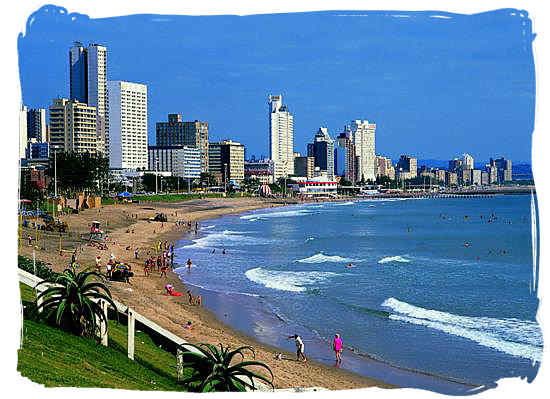
Located at the southern tip of Africa, with coastlines on the Atlantic and Indian Oceans, is divided into three natural regions: a narrow coastal lowland is warm and humid, which is grown mainly in sugar cane plantations, and vineyards in the Cape region in the interior of the vast plateau stretching from the Veld, who constitute 40% of the territory where they were installed and large farms, wheat and corn and cattle and sheep ranches, and the northwest Rand, the mining region, with large cities and industries. The exploitation of mineral resources is the foundation of the economy is the world’s largest producer of gold and diamonds, manganese, and the second eighth of coal. Water resources are overexploited. Salinization is the greatest threat in dry regions.
Climate:
The South African summer may be too warm, especially in the Lowveld region, while the higher elevations are more pleasant this time of year. The mountainous area is characterized by fog and rain. Northeastern areas tend to be extremely wet and coasts are ideal for swimming and enjoy the beautiful beaches and sun. In spring, the Western Cape Province and Northern Cape in all its glory, adorned with hundreds of wildflowers. In most parts of the country, winters are mild, but in areas of higher altitude are produced occasional frost and snow.
Important Information:
The entry requirements vary according to South Africa for the source of the visitor. Travelers from Argentina, Chile, Ecuador, USA, Paraguay, the EU, Uruguay and Venezuela do not require a visa, only a valid passport, if the stay is less than 90 days, while nationals of Bolivia, Costa Rica, Mexico and Peru could only stay 30 days without a visa.
The peak seasons in which the accommodations and resorts are full and prices increased to reach double are December, January, April, July and September.
The currency is the Rand (ZAR) to which you can convert foreign currency at banks, exchange houses and large hotels. ATMs abound (though they have a daily limit for cash withdrawals) and major credit cards are accepted everywhere except at service stations, which must be paid in cash. Visitors should be careful when working with ATM, as they tend to be frequented by scammers. Travelers checks and some foreign currencies are accepted in hotels and most important business, but with a commission if the commission is to be avoided, they can be exchanged at banks.
Being a waiter is half of life, so that those engaged in this profession expecting a 10% if the restaurant bill does not include a service charge. Receiving a tip for the usual care for janitors, taxi drivers and workers in service stations.
With regard to health issues, a certificate of vaccination against yellow fever for those who come from an infected area. There is also a risk of malaria in Mpumalanga, the lower areas of Northern Province and north-eastern KwaZulu Natal. It is important to note that South Africa is a country affected by HIV / AIDS and take necessary precautions.
Where to go ?
Cape Town, a mix of Europe and Africa, is one of the most attractive of the continent and the oldest in the country. Some of the places worth visiting here are located in Central, City Bowl. Some good choices are the South African Museum has an interesting collection of dioramas of dinosaurs, animals and objects of indigenous civilizations, the Castle of Good Hope, built between 1666 and 1679 and one of the oldest buildings in the southern continent, the District Six Museum The Victoria and Alfred Waterfront is located north of downtown and is specially geared to tourism. You can also go up by cable car to Table Mountain to enjoy the stunning views and hiking that is from the top or visit the Botanical Garden Kirtenbosch, located on the slopes of Mt. Johannesburg, known as Jo’burg, eGoli, Jozias or City of Gold, is the country’s largest city and features an interesting contrast and separation between white and black people. Here it is worth visiting the Township, the neighborhoods where blacks live, but to organize a tour guide with a black trust.
Darkensberg is located on the border with the Kingdom of Lesotho, is a massive basalt that has been inhabited for thousands of years they have left their fingerprints on the paintings by the San people in several locations. Here you can visit national parks, attractions such as the Royal Natal National Park, whose southern tip is to visit the imposing cliff Amphitheater where rushed five sections of the falls Tugela. In addition, there are wonderful trails to enjoy the rich flora of the place and practice a bit of climbing.

In the northeastern province of Kwa Zulu / Natal is the subtropical city of Durban is famous for its nightlife and beautiful beaches, ideal for surfing. Besides the beaches and nightclubs, you can visit the Town Hall has an art gallery of contemporary South African artists and a Natural Science Museum, the Museum of Local History, a collection of colonial objects and the Center for African Art and its collection of works by artists in rural areas. West of the downtown district is the crazy Indian, whose points of interest are the Victoria Street Market, the Hindu temple Alayam and the Juma Mosque.

Festivals:
Festivals which are recommended to engage the National Arts Festival, which, in addition to opera, theater and art shows art can be witnessed in South African languages performed by students. The Jacaranda Festival is held the third week of October in Pretoria one full of flowers. At the same carried out in the third week of August, the Pretoria Show. You can also enjoy the alternative program of Arts Alive Festival in Johannesburg in September and October. Moreover, the powers of international rugby and cricket are considered major events.
Leave a Reply
You must be logged in to post a comment.
Recent Comments